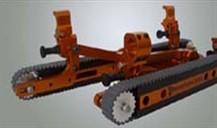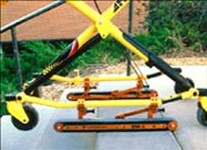Hospitals eTool
Heliport » Work-related Musculoskeletal Disorders

Hazard
Employees are exposed to ergonomics-related risk factors (e.g., heavy lifting in awkward body positions) when they transfer patients to and from a helicopter to carts or gurneys.
Frequent lifting and positioning of patients in awkward postures (e.g., twisting, bending to the side, back hyperextension or flexion, reaching across the patient) and using a great deal of force (for example, while repositioning a physically dependent patient) or pushing wheelchairs or gurneys across elevation changes or up ramps, may lead to work-related musculoskeletal disorders (i.e., strain and sprain injuries to back and shoulder areas).




Recognized Controls and Work Practices
- Provide a safe and rapid way of moving patients from a heliport to the hospital emergency room using mechanical patient transfer equipment.
- Provide a moveable and adjustable stretcher inside the helicopter to avoid employee twisting and minimize manual lifting.
- Provide power gurneys when moving patients from the heliport into the hospital. Even obese (bariatric) patients can be accommodated with upgraded design of the power gurneys.
- Descent Control System (DCS): Emergency evacuation or retrieval from older or disabled structures may require using stairs or negotiating rough terrain when moving patients. These devices allow ambulance technicians or emergency evacuation personnel to safely move a loaded hospital cot or gurney down stairs or any steep decline. The device easily attaches to any ambulance cot currently in-use by the pre-hospital care market. When not in use, the DCS simply folds up and out of the way.
Additional Information
- Hazard Identification Training Tool. OSHA.
- Worker Safety in Hospitals: Caring for Our Caregivers – Safe Patient Handling. OSHA.
- Safe Patient Handling. OSHA Safety and Health Topics page.
- Safe Patient Handling: Preventing Musculoskeletal Disorders in Nursing Homes. OSHA Publication 3708, (February 2014).
- Improving Patient and Worker Safety: Opportunities for Synergy, Collaboration and Innovation. The Joint Commission.
- Guidelines for Nursing Homes: Ergonomics for the Prevention of Musculoskeletal Disorders. OSHA Publication 3182, (2009). Section III, Identifying Problems and Implementing Solutions for Resident Lifting and Repositioning: includes an assessment of resident handling tasks that can help to determine the safest methods for performing necessary tasks for moving individual patients without injuring workers. A list of sample equipment solutions for patient lifting and repositioning tasks is also included.
- Ergonomics. OSHA Safety and Health Topics Page.
- Inspection Guidance for Inpatient Healthcare Settings. (June 25, 2015). OSHA memorandum establishing guidance for inspections conducted in inpatient healthcare settings.
- Also see Hospital-wide Hazards - Work-related Musculoskeletal Disorders.

